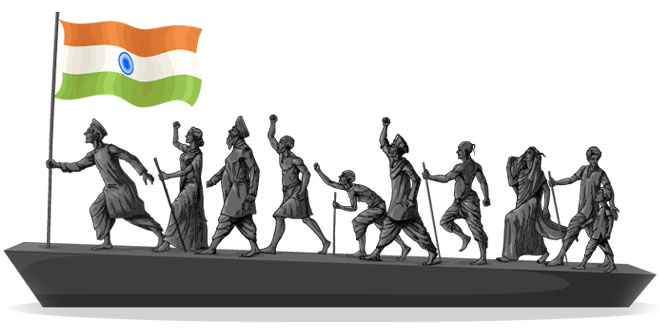Question: When did Mahatma Gandhi return to India?
Answer: 1915
Question: Name any two methods used by Gandhiji to fight against the Britishers.
Answer: (1) Satyagraha (2) Non-Violence
Question: Name any four places where Satyagraha was launched by Gandhiji.
Answer: (1) Champaran – Bihar (2) Kheda – Gujarat (3) Ahmedabad – Gujarat (4) South Africa
Question: Name the Act which gave enormous powers to the government to repress political activities.
Answer: Rowlatt Act
Question: Name the General who was responsible for the Jallianwala Bagh incident.
Answer: General Dyer
Question: Why did Mahatma Gandhi call off Rowlatt Satyagraha?
Answer: Gandhiji called off Rowlatt Satyagraha due to spread of violence.
Question: What was Rowlatt Act?
Answer: It was the black act which gave the government I and the police to repress political activities, and allowed detention of political prisoners without trial for two years.
Question: How did Mahatma Gandhi react against the Rowlatt Act?
Answer: Mahatma Gandhi decided to launch a non – violent Civil Disobedience Movement against the unjust law.
Question: Mention the limitation of Rowlatt Satyagraha.
Answer: (i) It was limited mostly in cities and towns. (ii) People started using violent methods so Gandhiji had to call off the Satyagraha.
Question: Why was the Khilafat Committee formed?
Answer: The Khilafat Committee was formed to defend the khalifa’s temporal powers.
Question: Who was the writer of the book ‘Hind Swaraj’?
Answer: Mahatma Gandhi
Question: When was the Non-cooperation Khilafat Movement launched?
Answer: January 1921
Question: Who was Baba Ramchandra?
Answer: He was a Sanyasi who led Non-cooperation movement in Awadh.
Question: What were the major demands of the peasants who participated in the Noncooperation Khilafat movement? Mention any two?
Answer: (1) Reduction of revenue (2) Abolition of begar
Question: Why the tribal peasants participated in the Non-cooperation Khilafat movement?
Answer: The colonial government had closed large forests areas, preventing people from entering the forests to graze their cattle or to collect tueiwood and fruits.
Question: What was the Inland Emigration Act of 1859?
Answer: Under the Inland Emigration Act of 1859, plantation workers were not permitted to leave the tea gardens without permission.
Question: When was Non-Cooperation Movement withdrawn by Gandhiji? Give reason.
Answer: The Non Cooperation movement was withdrawn in 1922 because of a violent incident in Chauri Chaura.
Question: Who were the founders of the Swaraj Party?
Answer: C.R. Das and Motilal Nehru.
Question: Who was Alluri Sitaram Raju?
Answer: He was a nationalist of Gudem Hills of Andhra Pradesh who lead the Non Cooperation of 1921.
Question: What was the course of Dandi March?
Answer: The march was over 240 miles, from Gandhiji’s ashram in Sabarmati to the Gujarati coastal town of Dandi.
Question: Who was Abdul Ghaffar khan?
Answer: He was a devout disciple of Mahatma Gandhi who lead the Civil Disobedience movement in Peshawar.
Question: Name the Commission which was formed to look into the functioning of the constitutional system in India. Who was the President of the Commission.
Answer: Simon Commission. Sir John Simon was the President.
Question: What is the importance of the Lahore Congress session of 1929?
Answer: It was the session in which the demand of ‘Purna Swaraj’ or full independence for India was made.
Question: When and under whose leadership was Civil Disobedience movement launched?
Answer: The Civil Disobedience Movement was launched in 1930 under the leadership of Mahatma Gandhi.
Question: What was the main motive of the Salt March?
Answer: To break the Salt law.
Question: Which incident marked the beginning of the Civil Disobedience Movement?
Answer: On 6th April, Mahatma Gandhi ceremonially violated the Salt Act, manufacturing salt by boiling sea water. This incident marked the beginning of the Civil Disobedience Movement.
Question: What was Gandhi-Irwin Pact?
Answer: The pact which was signed between Gandhiji and Lord Irwin on 5th March 1931. Under this pact Gandhiji consented to participate in a Round Table Conference in London whereas government agreed to release all the political prisoners.
Question: When was Gandhi Irwin Pact signed?
Answer: 5th March 1931.
Question: Why the rich peasants became enthusiastic supporters of the Civil Disobedience movement?
Answer: For them the fight for Swaraj was a struggle against high revenues.
Question: The Congress was unwilling to support ‘no rent’ campaigns during Civil Disobedience movement. Give reason.
Answer: Because it did not want to raise issue that might upset the rich peasants and landlords.
Question: Who announced a vague offer of ‘Dominion Status’ for India in 1929?
Answer: Viceroy Irwin
 Class Notes NCERT Solutions for CBSE Students
Class Notes NCERT Solutions for CBSE Students





